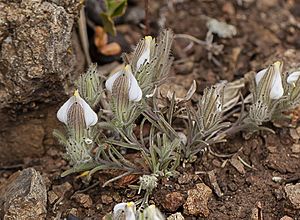Mt. Diablo bird's-beak facts for kids
Quick facts for kids Mt. Diablo bird's-beak |
|
|---|---|
 |
|
| Scientific classification | |
| Genus: |
Cordylanthus
|
| Species: |
nidularius
|
The Mt. Diablo bird's beak (scientific name: Cordylanthus nidularius) is a very rare flowering plant. It's called 'bird's beak' because its flowers look a bit like a bird's beak! This special plant belongs to a plant family called Orobanchaceae.
Where Does the Mt. Diablo Bird's Beak Live?
This plant is super unique because it only lives in one place in the whole world: Mount Diablo in Contra Costa County, California. When a plant or animal only lives in one specific area, we say it is endemic to that place.
The Mt. Diablo bird's beak grows in a type of shrubland called chaparral. It especially likes a special kind of ground called serpentine soil. This soil is found in rocky areas and has unique minerals. You can find this plant at heights between 600 and 800 meters (about 1,970 to 2,625 feet) above sea level.
What Does the Mt. Diablo Bird's Beak Look Like?
The Mt. Diablo bird's beak is a small plant that lives for only one year. Plants that live for just one year are called annual plants. It has leaves that are a mix of red, gray, and green. These leaves are covered in tiny, sticky hairs and soft, woolly fibers.
Its flowers are quite interesting! Each flower is surrounded by 2 or 3 leaf-like parts called bracts. These bracts are divided into three thin sections, up to 1.5 centimeters (about 0.6 inches) long. The main part of the flower, called the corolla, is a white pouch with purple streaks. This pouch is tucked inside a cup-like structure called the calyx, which is made of leaf-like parts called sepals. The Mt. Diablo bird's beak blooms during July and August.
Why Is the Mt. Diablo Bird's Beak in Danger?
This plant is considered a critically endangered species. This means it is at a very high risk of disappearing forever. It is listed as endangered by both the state of California and the California Native Plant Society.
Right now, we only know of one place where this plant grows on Mount Diablo. This last remaining group of plants is threatened by people building new trails and by outdoor activities like hiking. It might also be affected by efforts to stop wildfires, which can change the natural environment the plant needs to survive. Protecting this special plant is very important!

